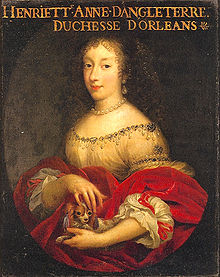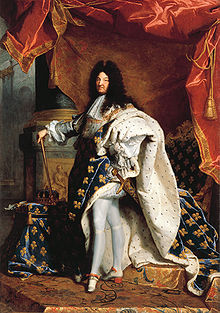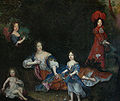- Françoise-Athénaïs, marquise de Montespan
-
Athénaïs de Montespan Marquise de Montespan 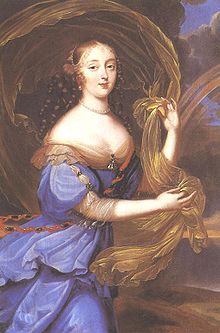
Contemporary portrait of Françoise by an unknown artist Spouse(s) Louis Henri de Pardaillan de Gondrin Issue Louis Antoine, Duke of Antin
Marie Christine de Pardaillan de Gondrin
Louis Auguste, Duke of Maine
Louis César, Count of Vexin
Louise Françoise, Duchess of Bourbon
Louise Marie Anne, Mademoiselle de Tours
Françoise Marie, Duchess of Orléans
Louis Alexandre, Count of ToulouseFull name Françoise Athénaïs de Rochechouart de Mortemart Noble family House of Pardaillan de Gondrin
House of RochechouartFather Gabriel de Rochechouart de Mortemart Mother Diane de Grandseigne Born 5 October 1641
Lussac-les-Châteaux, FranceBaptised 5 October 1641
Lussac-les-Châteaux, FranceDied 27 May 1707 (aged 65)
Bourbon-l'Archambault, FranceOccupation Maîtresse en titre of Louis XIV Françoise Athénaïs de Rochechouart de Mortemart, marquise of Montespan (5 October 1641 – 27 May 1707), better known as Madame de Montespan, was the most celebrated maîtresse en titre of King Louis XIV of France, by whom she had seven children.
Born into one of the oldest noble families of France, the House of Rochechouart, Madame de Montespan was called by some the true Queen of France during her romantic relationship with Louis XIV due to the pervasiveness of her influence at court during that time.[1]
Her so-called "reign" lasted from around 1667, when she first danced with Louis XIV at a ball hosted by the king's younger brother, Philippe I, Duke of Orléans, at the Louvre, until her alleged involvement in the notorious Affaire des Poisons in the late 1670s to 1680s. Her immediate contemporary was Barbara Villiers, mistress of King Charles II of England.
She is an ancestress of several royal houses in Europe, including those of Spain, Italy, Bulgaria and Portugal.[2]
Contents
Early life
Françoise de Rochechouart de Mortemart was born on 5 October 1641 and baptised the same day at the Château of Lussac-les-Châteaux[3] in today's Vienne department, in the Poitou-Charentes region in France, Françoise (as a précieuse, she later adopted the name "Athénaïs"), Mlle de Tonnay-Charente, possessed the blood of two of the oldest noble families of France through her parents, Gabriel de Rochechouart, Duke of Mortemart, Prince of Tonnay-Charente, and Diane de Grandseigne.
From her father, she inherited the famous Mortemart esprit ("wit"). As a young girl, she often travelled with her mother between the family estates and the court at the Louvre in Paris. At the age of twelve, she began her formal education at the Convent of St Mary at Saintes, where her sister Gabrielle had started hers almost a decade earlier. Her siblings were:
- Gabrielle (1633–1693), who married Claude Léonor Damas de Thianges, Marquess of Thianges and had issue.
- Louis Victor (25 August 1636-1688), known as the Marquess of Vivonne, who was an enfant d'honneur and a friend of Louis XIV of France in his youth.
- Marie Madeleine Gabrielle Adélaïde (1645–1704), who due to her relationship with Françoise-Athénaïs, was known as the Queen of Abbesses.
At the age of twenty, Françoise-Athénaïs became a maid-of-honour to the king's sister-in-law, Princess Henrietta Anne of England, who was known at court by the traditional honorific of Madame. Later, because of the relationship between her mother and the queen dowager, Anne d'Autriche, Françoise-Athénaïs was appointed to be a lady-in-waiting to the king's wife, Marie-Thérèse d'Autriche.
Marriage
On 28 January 1663, Françoise married Louis Henri de Pardaillan de Gondrin, Marquess of Montespan (1640–1701), who was a year her senior. Françoise had previously been engaged to his brother, but the brother had been killed in a duel after a ball at the Louvre. Following his death, it was decided that Françoise should marry his younger sibling. The wedding ceremony took place in a chapel at the Église Saint-Eustache in Paris. The couple had two children:
- Marie Christine de Pardaillan de Gondrin (1663–1675), who died at the Château de Bonnefont, one of her father's castles in Gascony.[4]
- Louis Antoine de Pardaillan de Gondrin, Marquess of Antin (1665–1736); later Duke of Antin. Louis Antoine had a cordial relationship with his younger half-brothers, the Duke of Maine and the Count of Toulouse.
The couple lived in a small house close to the Louvre, which allowed Madame de Montespan to attend court and carry out her duties there as a lady-in-waiting to the Duchess of Orléans. Beauty was only one of Madame de Montespan's many charms. She was a cultured and amusing conversationalist, who won the admiration of such literary figures as letter-writer Madame de Sévigné and diarist Saint-Simon. In addition, she kept abreast of political events. This had the effect of making her even more appealing to men of intellect and power.
It was said that she once had an affair with the renowned chef François Vatel during festivities at the Château de Chantilly.[citation needed]
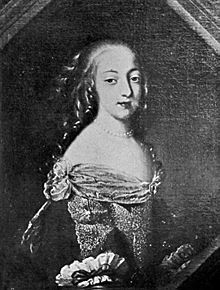 Françoise while known as Mademoiselle de Tonnay-Charente.
Françoise while known as Mademoiselle de Tonnay-Charente.
Rise as Maîtresse-en-titre
Madame de Montespan astounded the court by openly resenting the position of Queen Marie-Thérèse d'Autriche,[5] the daughter of the King and Queen of Spain, Philip IV and Elisabeth de France. A scandal arose when the Duchess of Montausier, governess of the royal children and lady-in-waiting to the Queen, was accused of acting as a go-between in order to secure the governorship of the Dauphin for her husband, the Duke of Montausier.[6]
By 1666, Madame de Montespan was trying to take the place of Louis XIV's current mistress, Louise de La Vallière. Using her wit and charm, she sought to ingratiate herself with the king. She also became close to the Dauphin, whose affection for her never wavered.
She also became friends at court with another lady-in-waiting to the queen, Louise Boyer, the wife of Anne, Duke of Noailles. Montespan's youngest son, the Count of Toulouse, would later marry one of Boyer's grand-daughters.
Illegitimate children
The first of the seven children that Madame de Montespan bore to the king was born in March 1669. The new-born child, a girl, Louise Françoise de Bourbon (1669–1672), was entrusted to one of Madame de Montespan's friends, Madame Scarron (the future marquise de Maintenon) to raise. To house the child and Madame Scarron, the King bought a small house in the village of Vaugirard[7] on the outskirts of Paris.
In 1673, the couple's three living illegitimate children were legitimatised by Louis XIV and given the royal surname of de Bourbon. Their mother's name, however, was not mentioned in the legitimisation documents. This was because Madame de Montespan was still married to the marquis de Montespan at the time. If their maternal parentage had been revealed, the marquis could have claimed Madame de Montespan's illegitimate children with the king as legally his own. The eldest, a son, Louis-Auguste de Bourbon, became the duc du Maine; the second child, a son, Louis-César de Bourbon, became the comte de Vexin; and the third, a daughter, Louise-Françoise de Bourbon, became Mademoiselle de Nantes. As Madame de Montespan spent the majority of her time immersed in the social whirl of the court, the three had little contact with their busy mother and spent most of their childhood with their governess, Madame Scarron.
In 1674, an official separation with her husband was declared by the Procureur général Achille de Harlay, assisted by six judges at the Châtelet. When Louis's affections showed signs of cooling, Madame de Montespan became nervous. She allegedly resorted to black magic in order to get him back. She may have started to consider using poison against potential rivals for the king's affections as early as 1676.[citation needed]
Due to her role in royal adultery, the Roman Catholic Church soon became her adversary. In 1675, the priest Lécuyer refused to give her absolution, which was necessary for her to take Easter communion, a requisite for all Catholics. Father Lécuyer raged,
Is this the Madame that scandalises all France? Go abandon your shocking life and then come throw yourself at the feet of the ministers of Jesus Christ.
The King appealed to the priest's superiors, but the Church refused to yield to the king's demands. After a short separation, the King and Madame de Montespan resumed their relationship, resulting in the birth of two more children, Françoise Marie de Bourbon, Mademoiselle de Blois, in 1677, and Louis-Alexandre de Bourbon, comte de Toulouse, in 1678. Both were to be legitimised in 1681.
The Affaire des Poisons, which erupted in September 1677, was to be the beginning of the end of the reign of La Montespan.[8][9] Suspicion that Madame de Montespan might be capable of murder or worse began when the King's eye strayed to another beauty, the Duchess of Fontanges. Madame de Montespan's relegation to the position of superintendent of the Queen's household as a result brought matters to a head. Before any more developments in her romance with the King could occur, Mlle de Fontanges died in 1681. Many at the time suspected that she had been poisoned by her rival, although none could prove it. It is now believed that Mlle de Fontanges died from natural causes.
 Mme de Montespan, by Pierre Mignard, c 1670
Mme de Montespan, by Pierre Mignard, c 1670
Royal scandal and fall
Affaire des Poisons
Long assumed to have been involved in the infamous Affaire des Poisons, Madame de Montespan has never been conclusively implicated. Gabriel Nicolas de La Reynie, Paris' first Lieutenant General of Police and the chief judge of the court, before whom the famous poisoning cases were brought, heard testimony that placed Madame de Montespan's first visits to the so-called witch Catherine Monvoisin, known as La Voisin, in 1665. Initially, La Voisin reportedly just gave Madame de Montespan love potions concocted of repulsive ingredients for Louis XIV to take, in the hope that such magic would gain Madame de Montespan the king's love and help her replace Louise de La Vallière in her role as maîtresse-en-titre.
In 1666, Madame de Montespan supposedly went so far as to allow a priest, Etienne Guibourg, to perform a black mass over her nude body[10] in a blood-soaked ceremony, which was also said to have included infant sacrifice. Whatever the truth in these allegations, in July 1667, Madame de Montespan became the king's new mistress even though Louise was carrying his child, Louis de Bourbon, comte de Vermandois.
In addition to seeking Louis' love, some charged Madame de Montespan with also conspiring to kill him. However, certain inconsistencies in this testimony suggest that the royal mistress was innocent of these charges. However, suspicion was thrown onto Madame de Montespan because the name of her maid, Mlle Desœillets, was frequently mentioned in connection with La Voisin in the evidence brought before the Chambre Ardente.
Indeed, if anyone was attempting to kill the king, it was more likely Claude de Vin des Œillets, who had an illegitimate child fathered but not publicly acknowledged by Louis. Presumably, the maid resented the loss of Louis' attention. Olympia Mancini, Countess of Soissons, herself a former mistress of the king and well-known intrigante, was also implicated in the conspiracy . From the end of 1680 onwards, Louvois, Jean-Baptiste Colbert and Madame de Maintenon all helped to hush up the affair in order to prevent further scandal about the mother of the king's legitimised children. Concerning the king's need to avoid shocking scandal, Police Chief La Reynie said:
the enormity of their crimes proved their safeguard.
Exile
Even after the scandal had forced Louis XIV and Madame de Montespan apart, the king continued to visit her daily in her rooms at the palace. Apparently her brilliance, charm, and spirited conversation mitigated to some extent her reduced status as a discarded mistress.
In 1691, no longer in royal favour, Madame de Montespan retired to the Filles de Saint-Joseph convent, in the rue Saint-Dominique[11] in Paris, with a pension of half a million francs. In gratitude for her departure, the king made her father the governor of Paris, her brother, the duc de Vivonne, a marshal of France, and one of her sisters, Gabrielle, the abbess of the wealthy Fontevraud Abbey.
In her long retirement, Madame de Montespan donated vast sums to hospitals and charities. She was also a generous patron of letters, and befriended Corneille, Racine and La Fontaine.
Later life
Death
The last years of her life were given up to a very severe penance.[citation needed] Real sorrow over her death was felt by her three youngest children. She died on 27 May 1707 at the age of sixty-five while taking the waters at Bourbon-l'Archambault in order to try and heal an illness. The king forbade her children to wear mourning for her.
Effects
As a mark of respect for the death of their beloved mother, the duchesse de Bourbon, duchesse d'Orléans and the comte de Toulouse, who were very close to her, refused to go to any court gatherings. Her eldest (and most disloyal) child with the king, the duc du Maine, though, was hardly able to conceal his joy on the death of his mother. He had always considered Madame de Maintenon to be more of a mother to him.
After hearing of the death of Françoise-Athénaïs, Madame de Maintenon is said to have run to her privy and wept bitterly. Françoise-Athénaïs had after all helped her get into court and put her in charge of her children, the position that originally allowed Madame de Maintenon to gain the king's attention.
Nature and appearance
Athénaïs was considered breathtakingly beautiful by the standards of her time. She had thick, curly wheat-colored hair that fell in ringlets around her face so beautifully that even the Queen copied her hairstyle. Her eyes were huge and blue, her lips full and her figure sensuously curvaceous. All of these qualities appealed to the sensibilities of beauty at the time. Her love of mockery, infectious laughter and quick wit were engaging, as were her intelligence and flirtatious interplay. Steeped in sensualism, she is often described as a hedonist with a fondness for music, dancing, the arts, food and love-making.[citation needed]
She had an extravagant and demanding nature and possessed enough charm to usually get what she wanted. She was expensive and glorious, like the Palace of Versailles itself. Her apartments were filled with pet animals and thousands of flowers; she had a private gallery, and costly jewels were showered upon her. She was highly discriminating as regards to the quality of the gems; returning them if they did not meet her exacting standards. She was given the nickname Quanto ("How much", in Italian). Her love for food and her numerous pregnancies caused her to gain weight in her late thirties until her pleasingly plump figure became undesirably fat.[12]
Children by Louis XIV
Louis XIV and Madame de Montespan had seven children, only four of whom survived childhood:
Louise Françoise de Bourbon (1669-1672)
-
- She was the first child to be placed in the care of the future Madame de Maintenon.
Louis Auguste de Bourbon (1670-1736)
-
- Legitimised in December 1673, and given the title of Duke of Maine;
- Married Anne Louise Bénédicte de Bourbon;
- Had issue but no surviving descendants;
- Was also the founder of the House of Bourbon-Maine;
- Inherited the Château de Clagny.
Louis César de Bourbon (1672-1683)
-
- Made Count of Vexin;
- Abbot of Saint-Germain-des-Prés (Abbé de Saint-Germain-des-Prés).
Louise Françoise de Bourbon (1673-1743)
-
- Named after Louise de La Vallière, her mother's predecessor as Louis XIV's official mistress; La Vallière was also her godmother;
- Legitimised in 1673;
- Given the title of Mademoiselle de Nantes after her legitimisation;
- Married Louis III, Prince of Condé;
- Upon her marriage, she assumed the title of duchesse de Bourbon and later princesse de Condé;
- The present members of the House of Orléans are descended from Louise-Françoise through her daughter Louise Élisabeth de Bourbon;
- The Palais Bourbon in Paris was built for her.
Louise Marie Anne de Bourbon (1674-1681)
-
- Legitimised in January 1676;
- Given the title of Mademoiselle de Tours.
Françoise Marie de Bourbon (1677-1749)
-
- Legitimised in 1681;
- Given the title of Mademoiselle de Blois, holding it until her marriage;
- Married the future regent Philippe II, Duke of Orléans in 1692;
- Through her son, Françoise Marie became a direct ancestor of Louis-Philippe I, King of the French and the modern House of Orléans.
Louis Alexandre de Bourbon (1678-1737)
-
- Legitimised in 1681;
- Given the title of Count of Toulouse;
- Married Marie Victoire de Noailles;
- The modern house of Orléans is also related to him through his granddaughter Louise Marie Adélaïde de Bourbon who married Philippe Égalité;
- He founded the house of Bourbon-Toulouse which with his son became the House of Bourbon-Penthièvre.
- Owned the Hôtel de Toulouse in Paris - today the seat of the Banque de France.
-
Madame de Montespan's two surviving daughters: the blonde Mademoiselle de Blois, with her older brunette sister, the Mademoiselle de Nantes
-
Louise Françoise some time after her marriage to Louis III, Prince of Condé
-
The Count of Toulouse, Madame de Montespan's youngest child
Legacy
House of Orléans
Through three of her children (Louise Françoise de Bourbon, Françoise Marie de Bourbon and the comte de Toulouse), Madame de Montespan became an ancestor of the modern House of Orléans and its present head, Henri d'Orléans, Count of Paris and Duke of France.
She is related to the present Portuguese and Brazilian Royal House of Braganza, the House of Este, the House of Austria-Este and the House of Savoy, mainly through her granddaughter by Françoise Marie de Bourbon, Charlotte Aglaé d'Orléans.
Françoise Marie's great-great-grandson was Louis-Philippe I, King of the French. Through Louis-Philippe's eldest daughter, Louise-Marie d'Orléans, the wife of King Leopold I of Belgium, Madame de Montespan is an ancestor of the present king of Belgium, Albert II, and his nephew, the present grand duke of Luxembourg, Henri.
Through Louis Philippe's son Ferdinand Philippe, Duke of Orléans she is also an ancestor of the Spanish Royal Family and its head, King Juan Carlos I of Spain. Through Louis-Philippe's fourth daughter, Princess Clémentine d'Orléans, the wife of Leopold's nephew, Prince August of Saxe-Coburg and Gotha, she is also the ancestor of the current pretender to the throne of Bulgaria, King Simeon II.
Château de Clagny
The Château de Clagny in Versailles was built between 1674 and 1680 from the drawings of Jules Hardouin-Mansart, Premier architecte du Roi, (First architect of the King), on land bought by Louis XIV in 1665. Madame de Sévigné wrote that its construction employed 1 200 workers and the cost was no less than two millions "livres".[13] The royal gardener André Le Nôtre created the gardens, which looked west toward the much larger palace of Versailles, of which Clagny was a smaller version. The château de Clagny was also famed for its gallery. In 1685, Louis XIV gave the magnificent palace to Madame de Montespan. At her death, Clagny was inherited by her oldest son, the duc du Maine, who, in turn, passed it on to his son, Louis-Auguste de Bourbon, prince de Dombes. The château reverted to the French crown in 1766 and was demolished in 1769.
Trianon de porcelaine
Louis XIV also had a pleasure pavilion, called the Trianon de porcelaine[14] built for Madame de Montespan, and surrounded by gardens, on the site of the former hamlet of Trianon which he had purchased near the Palace of Versailles. It was meant as a hideaway for the couple. Because of the fragility of the earthenware tiles used in its construction, the Trianon de porcelaine was demolished in 1687 and replaced by the Grand Trianon of pink marble (marbre rose des Pyrénées).
Fashion
At court, women copied Madame de Montespan's lavish style of dress which was often very loose and unfettered. The looseness allowed her to move more easily during her frequent pregnancies. Queen Marie-Thérèse d'Autriche unsuccessfully copied her coiffure in order to get the king to notice her more. Later, even after her departure from court, Madame de Montespan's favourite fashions were still being copied.
Court
As the king's official mistress, Madame de Montespan frequently joined the rest of the court as it escorted the king as he waged his many wars against the Dutch and Austrians. Below is a picture of one of the court processions. It shows Louis XIV and his wife, Queen Marie-Thérèse, in Arras in 1667 during the War of Devolution.
Madame de Montespan, is said to be the blonde woman at the center of the coach which would have also held the king's sister-in-law Madame, his first cousin La Grande Mademoiselle, the Queen and Madame de Montespan's older sister, the marquise de Thianges. Louis XIV stands behind the coach with his red hat while his younger brother, Monsieur, stands further to the right in blue.
-
A plan of the Château de Clagny and its gardens
-
The French Court at Arras in 1667
Ancestry
Ancestors of Françoise-Athénaïs, marquise de MontespanFurther reading
- Caylus (Madame de), Les Souvenirs de Madame de Caylus, Collection le Temps retrouvé VI, Mercure de France, Paris, 1965.
- Erlanger, Philippe, Louis XIV, Librairie Arthème Fayard, Paris, 1965.
- Erlanger, Philippe, Louis XIV, (translated from the French by Stephen Cox), Praeger Publishers, Inc., New York, 1970.
- Fraser, Antonia (Lady), Love and Louis XIV
- Freeman-Mitford, Nancy (Hon.), The Sun King
- Hilton, Lisa, Athénaïs:The Real Queen of France
- Lenotre, G. Le Château de Rambouillet, six siècles d'Histoire, Calman-Lévy, Paris, 1930.
- Petitfils, Jean-Christian, Madame de Montespan, Librairie Arthème Fayard, Paris, 1988 (ISBN 2213022429).
- Petitfils, Jean-Christian, Louis XIV, Perrin, Paris, 1999 (ISBN 2262012938).
- Verlet, Pierre, Le Château de Versailles, Librairie Arthème Fayard, Paris, 1961 & 1985.
In fiction
- She figured in Victorien Sardou's play L'Affaire des poisons (1907).
- She played a major role as the rival to the main character in "Angelique and the King" by Sergeanne Golon (1960).
- She also was a driving force in Judith Merkle-Riley's novel The Oracle Glass (1995).
- Madame de Montespan was also fictionally referenced as a Satanist in Chelsea Quinn Yarbo's vampire novel Hotel Transylvania (1978).
- She had a minor role in Chiho Saito and Kunihiko Ikuhara's manga series S to M no Sekai (2001), which was published in English as The World Exists For Me (2005).
- She was one of the many courtiers of Louis XIV in Alexandre Dumas, père's novel, The Vicomte de Bragelonne. She was seen more in her younger years as one of the maids of honor to Queen Marie-Thérèse and a close friend to Louise de La Vallière, Louis XIV's mistress at the period of the novel's action.
- She has a significant role in 'The Refugees' (1893) by Sir Arthur Conan Doyle where her fall from favour with Louis XIV is dramatically depicted
- She has a major role in 'The Orange Trees of Versailles' by Annie Pietri. It is set during the Affair of the Poisons and is written from the viewpoint of Marion, one of Madame de Montespan's maids. Marion disrupts Madame de Montespan's attempt to murder Queen Marie-Thérèse and is taken to work as a perfumer for the king and queen.
- She was played by the actress Marine Delterme in the film Vatel.
- She is a central character in Clare Colvin's novel The Mirror Makers (2003).
- She is a central figure in the collection of poetry, "Some Other Garden", by Jane Urquhart, first published as: "I am Walking in the Garden of His Imaginary Place". (2000; 1982)
- She makes an appearance in Le Roi Soleil, a French musical which opened in Paris in 2005 where she was portrayed by Lysa Ansaldi.
References
- ^ Lisa Hilton, Athénaïs: The Life of Louis XIV's Mistress - the Real Queen of France, Little, Brown 2002.
- ^ See the Descendants of Louis XIV of France for her extended family.
- ^ "Lussac-les-Châteaux - Wikipédia" (in (French)). Fr.wikipedia.org. http://fr.wikipedia.org/wiki/Lussac-les-Ch%C3%A2teaux. Retrieved 2009-05-19.
- ^ In the village of Montespan, in the Haute-Garonne department, in the Midi-Pyrénées Region of France. (French site) http://montespan31.blogspot.com/2008/05/39.html.
- ^ Her Spanish title, before her marriage, was Infanta María Teresa de Austria. In France, she was known as Marie-Thérèse d'Autriche.
- ^ Charles de Sainte-Maure, marquis de Montausier, was made duc et pair de France in 1664 and, in 1668, became the governor of the Dauphin. See: Lenotre, G. Le Château de Rambouillet, six siècles d'histoire, Chapter 2, Les précieuses, p. 29, Calman-Lévy, Paris, 1930
- ^ . The village of Vaugirard was on the outskirts of Paris on the site of today's metro station Vaugirard. http://fr.wikipedia.org/wiki/Rue_de_Vaugirard
- ^ Erlanger, Philippe, Louis XIV, Librairie Arthème Fayard, Paris, 1965,
- ^ Erlanger, Philippe, Louis XIV, (translated from the French by Stephen Cox), Praeger Publishers, New York, 1970, p.
- ^ Somerset, Anne, The Affair of the Poisons: Murder, Infanticide, and Satanism at the Court of Louis XIV (St. Martin's Press (12 October 2003) ISBN 0-312-33017-0), p. 227, from the testimony of La Voisin "Madame de Montespan was an habituée of the Abbé Guibourg's infamous Black Mass."
- ^ "Rue Saint Dominique". Paris-pittoresque.com. http://www.paris-pittoresque.com/rues/245.htm. Retrieved 2009-05-19.
- ^ Antonia Fraser, Love and Louis XIV, p 104-105, Anchor books, 2006
- ^ "Le chateau de Clagny". Versailles.forumculture.net. http://versailles.forumculture.net/excursions-en-ville-f11/le-chateau-de-clagny-t150.htm. Retrieved 2009-05-19.
- ^ varman7 (2002-04-18). "Bienvenue sur le Site Versailles 1687 - Le Trianon de Porcelaine". Versailles1687.free.fr. http://versailles1687.free.fr/trianon.htm. Retrieved 2009-05-19.
Other references
 This article incorporates text from a publication now in the public domain: Chisholm, Hugh, ed (1911). Encyclopædia Britannica (11th ed.). Cambridge University Press.
This article incorporates text from a publication now in the public domain: Chisholm, Hugh, ed (1911). Encyclopædia Britannica (11th ed.). Cambridge University Press.- See contemporary memoirs of Madame de Sévigné, of Saint-Simon, of Bussy-Rabutin and others; also the proceedings of the Chambre Ardente preserved in the Archives de la Bastille (Arsenal Library) and the notes of La Reynie preserved in the Bibliothèque Nationale.
Titles, styles, honours and arms
Titles and styles
- 5 October 1641 - 28 January 1663 Mademoiselle de Mortemart or Mademoiselle de Tonnay-Charente
- 28 January 1663 - November 1702 the Marchioness of Montespan (Madame la marquise de Montespan)
- November 1702 - 27 May 1707 the Dowager Marchioness of Montespan (Madame la marquise de Montespan Douairière)
External links
- Works by Françoise-Athénaïs, marquise de Montespan at Project Gutenberg
- Full text of Memoirs of Madame de Montespan from Project Gutenberg
- Works by or about Françoise-Athénaïs, marquise de Montespan in libraries (WorldCat catalog)
Categories:- 1641 births
- 1707 deaths
- People from Vienne
- Mistresses of Louis XIV of France
- 1680 crimes
- House of Rochechouart
- Marquesses of Montespan
- French ladies-in-waiting
- Louis XIV of France
- House of Bourbon
- French Roman Catholic nuns
- House of Pardaillan de Gondrin
Wikimedia Foundation. 2010.

